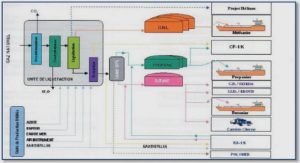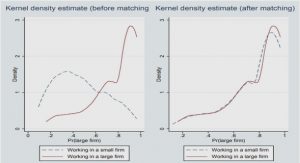Get Complete Project Material File(s) Now! »
Pharmaceutical applications of hot melt extrusion
HME produces solid dispersion, namely a dispersion of a drug in a solid carrier obtained by melting [7]. Three types of solid dispersions can be produced: (i) a “glassy suspension” (or “solid suspension”) where both the drug and the carrier are amorphous but the drug forms clusters within the polymer, (ii) a “crystalline suspension” where the drug remains crystalline in an amorphous carrier, and (iii) a “glassy solution” (or “solid solution”) where both the drug and the carrier are amorphous and completely miscible. In both glassy suspension and crystalline suspension, the drug is dispersed at the particular level, whereas in glassy solution, the drug is dispersed at the molecular level [9]. Extrudates with glassy solution have the advantage to increase drug availability. In a crystalline suspension, the drug crystals are dispersed in the amorphous matrix which releases drug in a sustained manner. Glassy suspension are the less stable with a high tendency to recrystallization due to the amorphous form of the drug clusters remaining in the formulation. The formation of one of these three solid dispersions depends on the drug solubility in the polymer, the drug – polymer interactions, and the stability of the formulation.
Hot melt extrusion pharmaceutical applications are:
– Immediate release: hot melt extrusion enables to entrap a drug in a molten material, so the bioavailability enhancement of poorly soluble drugs can be easily achieved [17–24],
– Modified release drug delivery systems such as time controlled, delayed, extended or site specific delivery can also be achieved by the preparation of hot melt extrudates [25–29],
– Taste masking of drug bitterness [30,31].
In addition to these current applications, some recent innovations have to be mentioned, such as abuse-deterrent/tamper-resistant formulations [14,32], co-extrusion [33–38], co-crystallization [39–42], and 3D printing [43–45].
Finally, thanks to the diverse downstream additional equipments (e.g. roller, pelletizer, grinder), the dosage forms can be varied [46]: granules, pellets and spheres [47–49], tablets and capsules [50], films [22,28], implants [51] for oral, transdermal, and transmucosal routes.
Material choice
In order to be suitable for hot melt extrusion, some relevant characteristics of the drug should be considered, (e.g. solubility, physical state, particle shape and size, flowability, melting temperature, thermal stability, glass transition temperature). In addition, particular properties will guide the choice of HME, for instance (i) if the drug is poorly soluble and need to have an enhanced bioavailability, (ii) if the drug is instable in acidic media or can irritate the gastric mucosa, (iii) if the drug has a specific absorption window and need to be targeted at a specific area of the gastro intestinal tract for the systemic or localized treatment of diseases (e.g. Crohn’s disease and ulcerative colitis).
Plasticizer and other additives
The extrusion can be difficult, due to the high viscosity [76–79] or thermal degradation [80– 82] of the polymeric material, that can be in some cases overcame by the addition of plasticizers. Plasticizers are low molecular weight compounds that can increase the free volume between polymer chains, allowing the decrease of the polymer glass transition temperature and melt viscosity [83]. Being more flexible, the polymer can be manufactured at lower temperature, improving the processing conditions (lower torque), and the physical and mechanical properties of the final product. Furthermore, a plasticizer should have a good affinity and compatibility to the polymer, and be sufficiently stable at elevated temperature. Some plasticizers often used for hot melt extrusion are: triacetin, citrate esters, fatty acid esters, and low molecular weight polyethylene glycols. It is also interesting to note that some drugs (e.g. ibuprofen, metoprolol tartrate) can have a plasticizing effect [71,84–88].
Other additives can also be used, especially to enhance the stability of polymers susceptible to degradation during hot melt extrusion, e.g. antioxidants, acid receptors and light absorbers.
Advantages and disadvantages of hot melt extrusion
As discussed previously, HME has many advantages: it is a continuous, free-solvent process with fewer processing steps, easy to scale-up with the possibility of in-line controls, it is suitable for many applications, and it is able to manufacture difficult processing drugs, for instance with low compressibility or poor stability (e.g. thermodynamic instability or instability due to processing method such as hydrolysis).
However, some disadvantages have been reported in the literature [7,73]. The main one is related to thermal processing, that limits the utilization of thermo-degradable compounds (e.g. microbial species and proteins), despite the addition of plasticizer may decrease the extrusion temperature. Moreover, although HME is an economical process with reduced production time and fewer processing steps, the initial cost induced by the investment in equipment, may be a real hurdle for the implementation of HME in the pharmaceutical industry. Finally, specific excipient are required and cleaning of the process is, with some cases, not flawless.
Table of contents :
I. INTRODUCTION
1. General
2. Hot melt extrusion technique
3. Oral drug administration and controlled drug delivery
4. Poly Ethylene Oxide
5. Purposes of this work
II. MATERIALS AND METHODS
1. Materials
2. Experimental methods
III. RESULTS AND DISCUSSION
Chapter 1: Adjustment of extrusion process parameters
1. The impact of extrusion temperature
2. The impact of extrusion screw speed
3. The impact of the dosage form size
4. Stability studies
Chapter 2: Importance of PEO molecular weight
1. In vitro drug release from hot melt extrudates
2. Physical characterization of hot melt extrudates
3. In vitro swelling behavior of hot melt extrudates during dissolution test
Chapter 3: The impact of drug nature and loading on drug release from PEO hot melt extrudates
1. The impact on processability and in vitro drug release
2. Physical characterization
3. In vitro swelling studies
Chapter 4: Hot melt extrusion versus direct compression
1. In vitro drug release from hot melt extrudates vs direct compressed tablets
2. Physical characterization
3. The impact of in vitro release conditions
IV. CONCLUSIONS AND PERSPECTIVES
REFERENCES






